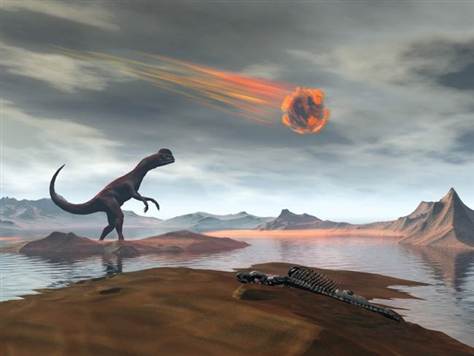The asteroid that created the Chicxulubt crater in the Yucatan Peninsula in Mexico and is believed to have led to the extinction of dinosaurs did not cause global firestorms across the Earth, researchers from Imperial College London, the University of Exeter, and the University of Edinburgh said.
The scientific team recreated the enormous energy released when the asteroid collided with Earth. Their study has been published in the Journal of the Geological Society.
According to their simulation, although the heat from the explosion was intense, it did not last long and could not have ignited live plants across the Earth. The scientists do not believe global firestorms followed the collision.

The mass extinction of life that occurred sixty-five million years ago is widely believed to have been caused by global firestorms following the asteroid that created the Chicxulubt crater.
The researchers found that near the 200km-wide crater in Mexico, the heat pulse would have lasted for about a minute at the most, which is nowhere near enough to ignite plant material across the planet.
But effects spread a long way
They did find, however, that the impact’s effects would have spread a long way – as far as New Zealand. The heat at that distance would have been much less intense, but longer lasting. The ground would have heated up for around seven minutes, which is enough time to ignite live plants.
Their laboratory experiment results showed that dry plant matter may have ignited, but green pine branches and other similar live plants most likely did not.
Dr Claire Belcher, a member of the Earth System Science group in Geography at the University of Exeter said:
“By combining computer simulations of the impact with methods from engineering we have been able to recreate the enormous heat of the impact in the laboratory. This has shown us that the heat was more likely to severely affect ecosystems a long distance away, such that forests in New Zealand would have had more chance of suffering major wildfires than forests in North America that were close to the impact.”
“This flips our understanding of the effects of the impact on its head and means that palaeontologists may need to look for new clues from fossils found a long way from the impact to better understand the mass extinction event.”
Animals and plants typically overcome the ravages of localized fires. While plants can re-colonize from other areas, animals either hide or hibernate. The research team does not believe the wildfires caused by the impact were directly capable of being responsible for the extinctions that occurred around that time.
Larger animals were probably harmed more
Communities of larger-sized animals may have found it harder to shelter from the heat and may have suffered serious losses, the authors added. But they reiterated their belief that the fires were unlikely to have been devastating enough to wipe out whole species.
University of Edinburgh scientist, Dr. Rory Hadden, said:
“This is a truly exciting piece of inter-disciplinary research. By working together engineers and geoscientists have tackled a complex, long-standing problem in a novel way. This has allowed a step forward in the debate surrounding the end Cretaceous impact and will help Geoscientists interpret the fossil record and evaluate potential future impacts.”
“In addition, the methods we developed in the laboratory for this research have driven new developments in our current understanding of how materials behave in fires particularly at the wildland-urban-interface, meaning that we have been able to answer questions relating to both ancient mass extinctions at the same time as developing understanding of the impact of wildfires in urban areas today.”
